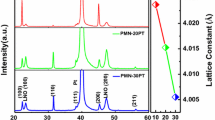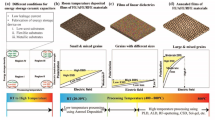Abstract
(Pb0.89La0.11)(Zr0.70Ti0.30)O3 (PLZT 11/70/30) relaxor ferroelectric (RFE) films were fabricated on Pt/Si substrates by aerosol deposition, which not only enabled the deposition of a film at room temperature but also increased the dielectric breakdown strength. Perovskite phase and microstructural analyses were carried out by x-ray diffraction and scanning electron microscopy techniques. A PLZT 11/70/30 RFE AD film annealed at 550 °C exhibited the best dielectric properties (εr ~ 1090, tanδ ~ 0.028) and typical relaxor-type slim polarization–electric field (P–E) hysteresis loop with relatively low remanent polarization (Pr ~ 6.81 µC/cm2) and coercive field (Ec ~ 118 kV/cm) even at a high applied electric field (~ 2500 kV/cm). These superior properties were achieved due to high phase purity, low defect densities, and well-tuned grain sizes of an annealed PLZT 11/70/30 RFE AD film. The PLZT 11/70/30 RFE AD film exhibited a high energy-storage density (Wrec ~ 44 J/cm3) which is attributed to the high dielectric breakdown strength, low hysteresis loss (Wloss ~ 10.3 J/cm3), and almost-electric-field-independent efficiency (η ~ 81%, change of ~ 6% with the change from low to high electric fields), calculated using the unipolar P–E hysteresis loop. The excellent temperature stability of the energy efficiency of the PLZT 11/70/30 RFE AD film makes it a promising material for high-temperature energy-storage capacitor applications.






Similar content being viewed by others
Abbreviations
- ε r :
-
Dielectric constant
- tanδ :
-
Loss
- P r :
-
Remanent polarization (µC/cm2)
- E c :
-
Coercive field (kV/cm)
- W rec :
-
Energy-storage density (J/cm3)
- W loss :
-
Hysteresis loss (J/cm3)
- η :
-
Efficiency
- P :
-
Polarization (µC/cm2)
- E :
-
Electric field (kV/cm)
- C :
-
Capacitance (F)
- V :
-
Voltage (V)
- I :
-
Current (A)
- P max :
-
Maximum polarization (µC/cm2)
- T c :
-
Transition temperature (°C)
- T m :
-
Dielectric maximum temperature (°C)
- P s :
-
Net polarization (µC/cm2)
References
H. Palneedi, M. Peddigari, G.-T. Hwang, D.-Y. Jeong, and J. Ryu, High-Performance Dielectric Ceramic Films for Energy Storage Capacitors: Progress and Outlook, Adv. Funct. Mater., 2018, 28(42), p 1803665
M. Peddigari, H. Palneedi, G.-T. Hwang, and J. Ryu, Linear and Nonlinear Dielectric Ceramics for High-Power Energy Storage Capacitor Applications, J. Korean Ceram. Soc., 2019, 56(1), p 1-23
M.S. Whittingham, Materials Challenges Facing Electrical Energy Storage, MRS Bull., 2008, 33(4), p 411-419
Z. Sun, Z. Wang, Y. Tian, G. Wang, W. Wang, M. Yang, X. Wang, F. Zhang, and Y. Pu, Progress, Outlook, and Challenges in Lead-Free Energy-Storage Ferroelectrics, Adv. Electron. Mater., 2020, 6(1), p 1900698
L. Yang, X. Kong, F. Li, H. Hao, Z. Cheng, H. Liu, J.-F. Li, and S. Zhang, Perovskite Lead-Free Dielectrics for Energy Storage Applications, Prog. Mater Sci., 2019, 102, p 72-108
S.A. Sherrill, P. Banerjee, G.W. Rubloff, and S.B. Lee, High to Ultra-High Power Electrical Energy Storage, Phys. Chem. Chem. Phys., 2011, 13, p 20714-20723
Q. Fan, M. Liu, C. Ma, L. Wang, S. Ren, L. Lu, X. Lou, and C.L. Jia, Significantly Enhanced Energy Storage Density with Superior Thermal Stability by Optimizing Ba(Zr0.15Ti0.85)O3/Ba(Zr0.35Ti0.65)O3 Multilayer Structure, Nano Energy, 2018, 51(July), p 539-545
B. Fan, F. Liu, G. Yang, H. Li, G. Zhang, S. Jiang, and Q. Wang, Dielectric Materials for High-Temperature Capacitors, IET Nanodielectrics, 2018, 1(1), p 32-40
A. Kumar, K.C. James Raju, J. Ryu, and A.R. James, Composition Dependent Ferro-Piezo Hysteresis Loops and Energy Density Properties of Mechanically Activated (Pb1−xLax)(Zr0.60Ti0.40)O3 Ceramics, Appl. Phys. A Mater. Sci. Process., 2020, 126(3), p 1-10
J. Gao, Q. Liu, J. Dong, X. Wang, S. Zhang, and J.-F. Li, Local Structure Heterogeneity in Sm-Doped AgNbO3 for Improved Energy-Storage Performance, ACS Appl. Mater. Interfaces, 2020, 12(5), p 6097-6104
X. Zhou, H. Qi, Z. Yan, G. Xue, H. Luo, and D. Zhang, Superior Thermal Stability of High Energy Density and Power Density in Domain-Engineered Bi0.5Na0.5TiO3–NaTaO3 Relaxor Ferroelectrics, ACS Appl. Mater. Interfaces, 2019, 11(46), p 43107-43115
Y. Fan, Z. Zhou, Y. Chen, W. Huang, and X. Dong, A Novel Lead-Free and High-Performance Barium Strontium Titanate-Based Thin Film Capacitor with Ultrahigh Energy Storage Density and Giant Power Density, J. Mater. Chem. C, 2020, 8(1), p 50-57
X. Hao, A Review on the Dielectric Materials for High Energy-Storage Application, J. Adv. Dielectr., 2013, 03(01), p 1330001
G.H. Haertling, Ferroelectric Ceramics: History and Technology, J. Am. Ceram. Soc., 1999, 82(4), p 797-818
L. Jin, F. Li, and S. Zhang, Decoding the Fingerprint of Ferroelectric Loops: Comprehension of the Material Properties and Structures, J. Am. Ceram. Soc., 2014, 97(1), p 1-27
A. Kumar, S.H. Kim, M. Peddigari, D.-H. Jeong, G.-T. Hwang, and J. Ryu, High Energy Storage Properties and Electrical Field Stability of Energy Efficiency of (Pb0.89La0.11)(Zr0.70Ti0.30)0.9725O3 Relaxor Ferroelectric Ceramic, Electron. Mater. Lett., 2019, 15(3), p 323-330
J.-H. Lim, J.-W. Kim, S.H. Lee, C. Park, J. Ryu, D.H. Choi, and D.-Y. Jeong, Fabrication of High Density BZN-PVDF Composite Film by Aerosol Deposition for High Energy Storage Properties, Korean J. Mater. Res., 2019, 29(3), p 175-182
J.-S. Lee, S. Yoon, J.-H. Lim, C.-K. Park, J. Ryu, and D.-Y. Jeong, Improvement of Energy Storage Characteristics of (Ba0.7Ca0.3)TiO3 Thick Films by the Increase of Electric Breakdown Strength from Nano-Sized Grains, Korean J. Mater. Res., 2019, 29(2), p 73-78
F. Forlani and N. Minnaja, Thickness Influence in Breakdown Phenomena of Thin Dielectric Films, Phys. Status Solidi, 1964, 4(2), p 311-324
N.H. Khansur, U. Eckstein, L. Benker, U. Deisinger, B. Merle, and K.G. Webber, Room Temperature Deposition of Functional Ceramic Films on Low-Cost Metal Substrate, Ceram. Int., 2018, 44(14), p 16295-16301
K. Sandeep, J. Pundareekam Goud, and K.C. James Raju, Resonant Spectrum Method for Characterizing Ba0.5Sr0.5TiO3 Based High Overtone Bulk Acoustic Wave Resonators, Appl. Phys. Lett., 2017, 111(1), p 012901
F. Ménil, H. Debéda, and C. Lucat, Screen-Printed Thick-Films: From Materials to Functional Devices, J. Eur. Ceram. Soc., 2005, 25(12), p 2105-2113
G. de Cicco, B. Morten, and M. Prudenziati, Elastic Surface Wave Devices Based on Piezoelectric Thick-Films, IEEE Trans. Ultrason. Ferroelectr. Freq. Control, 1996, 43(1), p 73-77
H.-B. Jung, J.-H. Lim, M. Peddigari, J. Ryu, D.H. Choi, and D.-Y. Jeong, Enhancement of Energy Storage and Thermal Stability of Relaxor Pb0.92La0.08Zr0.52Ti0.48O3-Bi(Zn0.66Nb0.33)O3 Thick Films through Aerosol Deposition, J. Eur. Ceram. Soc., 2020, 40(1), p 63-70
C. Lee, M. Kim, M.-Y. Cho, S.-M. Koo, J.-M. Oh, and D. Lee, Electrical Effect of High-Field Induced Diffusive Metal in the Ceramic Film Deposited by the Aerosol Deposition Method, Electron. Mater. Lett., 2019, 15(6), p 760-768
H.-K. Kim, S.-H. Lee, S.-G. Lee, and Y.-H. Lee, Densification Mechanism of BaTiO3 Films on Cu Substrates Fabricated by Aerosol Deposition, Electron. Mater. Lett., 2015, 11(3), p 388-397
J. Akedo, Aerosol Deposition of Ceramic Thick Films at Room Temperature: Densification Mechanism of Ceramic Layers, J. Am. Ceram. Soc., 2006, 89, p 1834-1839
W. Andrysiewicz, J. Krzeminski, K. Skarżynski, K. Marszalek, M. Sloma, and A. Rydosz, Flexible Gas Sensor Printed on a Polymer Substrate for Sub-Ppm Acetone Detection, Electron. Mater. Lett., 2020, 16(2), p 146-155
C.-K. Park, S. Lee, J.-H. Lim, J. Ryu, D. Choi, and D.-Y. Jeong, Nano-Size Grains and High Density of 65PMN-35PT Thick Film for High Energy Storage Capacitor, Ceram. Int., 2018, 44(16), p 20111-20114
M. Peddigari, H. Palneedi, G.-T. Hwang, K.W. Lim, G.-Y. Kim, D.-Y. Jeong, and J. Ryu, Boosting the Recoverable Energy Density of Lead-Free Ferroelectric Ceramic Thick Films through Artificially Induced Quasi-Relaxor Behavior, ACS Appl. Mater. Interfaces, 2018, 10(24), p 20720-20727
S. Bin Kang, M.G. Choi, D.Y. Jeong, Y.M. Kong, and J. Ryu, Energy Storage Properties of Nano-Grained Antiferroelectric (Pb, La)(Zr, Ti)O3 Films Prepared by Aerosol-Deposition Method, IEEE Trans. Dielectr. Electr. Insul., 2015, 22(3), p 1477-1482
B. Lu, P. Li, Z. Tang, Y. Yao, X. Gao, W. Kleemann, and S.G. Lu, Large Electrocaloric Effect in Relaxor Ferroelectric and Antiferroelectric Lanthanum Doped Lead Zirconate Titanate Ceramics, Sci. Rep., 2017, 7(February), p 1-8
M.R. Cicconi, N.H. Khansur, U.R. Eckstein, F. Werr, K.G. Webber, and D. Ligny, Determining the Local Pressure during Aerosol Deposition Using Glass Memory, J. Am. Ceram. Soc., 2020, 103(4), p 2443-2452
N.H. Khansur, U. Eckstein, K. Riess, A. Martin, J. Drnec, U. Deisinger, and K.G. Webber, Synchrotron X-Ray Microdiffraction Study of Residual Stresses in BaTiO3 Films Deposited at Room Temperature by Aerosol Deposition, Scr. Mater., 2018, 157, p 86-89
A. Kumar, K.C. James Raju, and A.R. James, Diffuse Phase Transition in Mechanically Activated (Pb1−xLax)(Zr0.60Ti0.40)O3 Electro-Ceramics, J. Mater. Sci. Mater. Electron., 2017, 28(18), p 13928-13936
A. Kumar, V.V. Bhanu Prasad, K.C. James Raju, and A.R. James, Ultra High Strain Properties of Lanthanum Substituted PZT Electro-Ceramics Prepared via Mechanical Activation, J. Alloys Compd., 2014, 599, p 53-59
J. Ryu, S. Priya, C.S. Park, K.Y. Kim, J.J. Choi, B.D. Hahn, W.H. Yoon, B.K. Lee, D.S. Park, and C. Park, Enhanced Domain Contribution to Ferroelectric Properties in Freestanding Thick Films, J. Appl. Phys., 2009, 106(2), p 024108
A.R. James, A. Kumar, V.V.B. Prasad, S.V. Kamat, V. Singh, P. Ghoshal, and A. Pandey, Tunability, Ferroelectric and Leakage Studies on Pulsed Laser Ablated (Pb0.92La0.08)(Zr0.60Ti0.40)O3 Thin Films, Mater. Chem. Phys., 2018, 211, p 295-301
R.D. Klissurska, A.K. Tagantsev, K.G. Brooks, and N. Setter, Effect of Nb Doping on the Hysteresis Parameters of Sol-Gel Derived Thin Films, Microelectron. Eng., 1995, 29(1–4), p 271-274
M. Adachi, T. Matsuzaki, T. Yamada, T. Shiosaki, and A. Kawabata, Sputter-Deposition of [111]-Axis Oriented Rhombohedral PZT Films and Their Dielectric, Ferroelectric and Pyroelectric Properties, Jpn. J. Appl. Phys., 1987, 26(4 R), p 550-553
R. Jimenez, C. Alemany, and J. Mendiola, Top Electrode Induced Self-Polarization in CSD Processed SBT Thin Films, Ferroelectrics, 2002, 268, p 131-136
A. Kumar, J.Y. Yoon, A. Thakre, M. Peddigari, D.-Y. Jeong, Y.-M. Kong, and J. Ryu, Dielectric, Ferroelectric, Energy Storage, and Pyroelectric Properties of Mn-Doped (Pb0.93La0.07)(Zr0.82Ti0.18)O3 Anti-Ferroelectric Ceramics, J. Korean Ceram. Soc., 2019, 56(4), p 412-420
A. Bootchanont, N. Triamnak, S. Rujirawat, R. Yimnirun, D.P. Cann, R. Guo, and A. Bhalla, Local Structure and Evolution of Relaxor Behavior in BaTiO3–Bi(Zn0.5Ti0.5)O3 Ceramics, Ceram. Int., 2014, 40(9), p 14555-14562
S. Bin Kang, H.S. Kim, J.G. Lee, C.K. Park, J. Ryu, J.J. Choi, B.D. Hahn, L. Wang, and D.Y. Jeong, Dielectric Properties of Pb(In1/2Nb1/2)O3-Pb(Mg1/3Nb2/3)O3-PbTiO3 Film by Aerosol Deposition for Energy Storage Applications, Ceram. Int., 2016, 42(1), p 1740-1745
H.J. Lee, S.S. Won, K.H. Cho, C.K. Han, N. Mostovych, A.I. Kingon, S.H. Kim, and H.Y. Lee, Flexible High Energy Density Capacitors Using La-Doped PbZrO3 Anti-Ferroelectric Thin Films, Appl. Phys. Lett., 2018, 112(9), p 092901
Y. Zhao, X. Hao, and Q. Zhang, Energy-Storage Properties and Electrocaloric Effect of Pb(1–3x/2)LaxZr0.85Ti0.15O3 Antiferroelectric Thick Films, ACS Appl. Mater. Interfaces, 2014, 6(14), p 11633-11639
X. Hao, Y. Wang, J. Yang, S. An, and J. Xu, High Energy-Storage Performance in Pb0.91La0.09(Ti0.65Zr0.35)O3 Relaxor Ferroelectric Thin Films, J. Appl. Phys., 2012, 112(11), p 114111
Y. Liu, X. Hao, and S. An, Significant Enhancement of Energy-Storage Performance of (Pb0.91La0.09)(Zr0.65Ti0.35)O3 Relaxor Ferroelectric Thin Films by Mn Doping, J. Appl. Phys., 2013, 114(17), p 174102
Acknowledgements
This study was supported by the National Research Foundation of Korea (NRF-2019R1A2B5B01070100).
Author information
Authors and Affiliations
Corresponding author
Additional information
Publisher's Note
Springer Nature remains neutral with regard to jurisdictional claims in published maps and institutional affiliations.
This article is part of a special topical focus in the Journal of Thermal Spray Technology on Aerosol Deposition and Kinetic Spray Processes. This issue was organized by Dr. Kentaro Shinoda, National Institute of Advanced Industrial Science and Technology (AIST); Dr. Frank Gaertner, Helmut-Schmidt University; Prof. Changhee Lee, Hanyang University; Prof. Ali Dolatabadi, Concordia University; and Dr. Scooter Johnson, Naval Research Laboratory.
Rights and permissions
About this article
Cite this article
Kumar, A., Kim, S.H., Thakre, A. et al. Increased Energy-Storage Density and Superior Electric Field and Thermally Stable Energy Efficiency of Aerosol-Deposited Relaxor (Pb0.89La0.11)(Zr0.70Ti0.30)O3 Films. J Therm Spray Tech 30, 591–602 (2021). https://doi.org/10.1007/s11666-020-01100-y
Received:
Revised:
Accepted:
Published:
Issue Date:
DOI: https://doi.org/10.1007/s11666-020-01100-y




